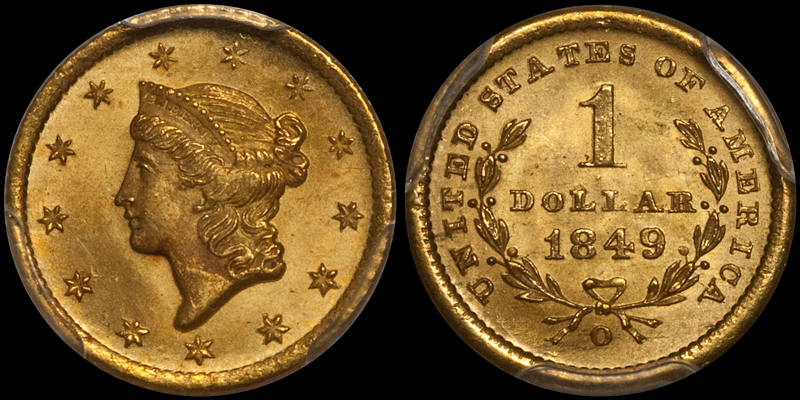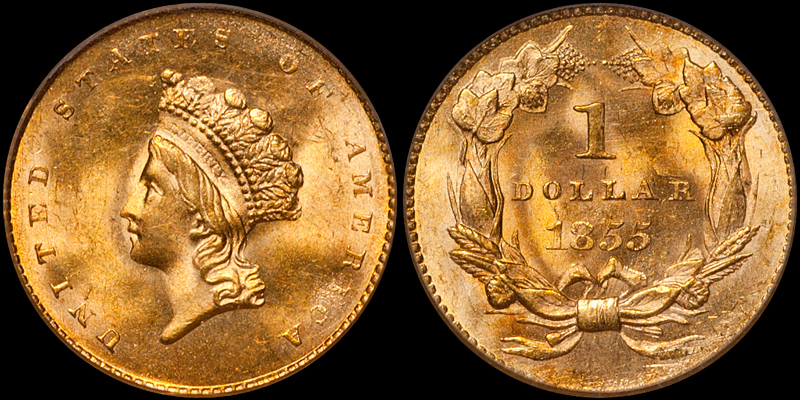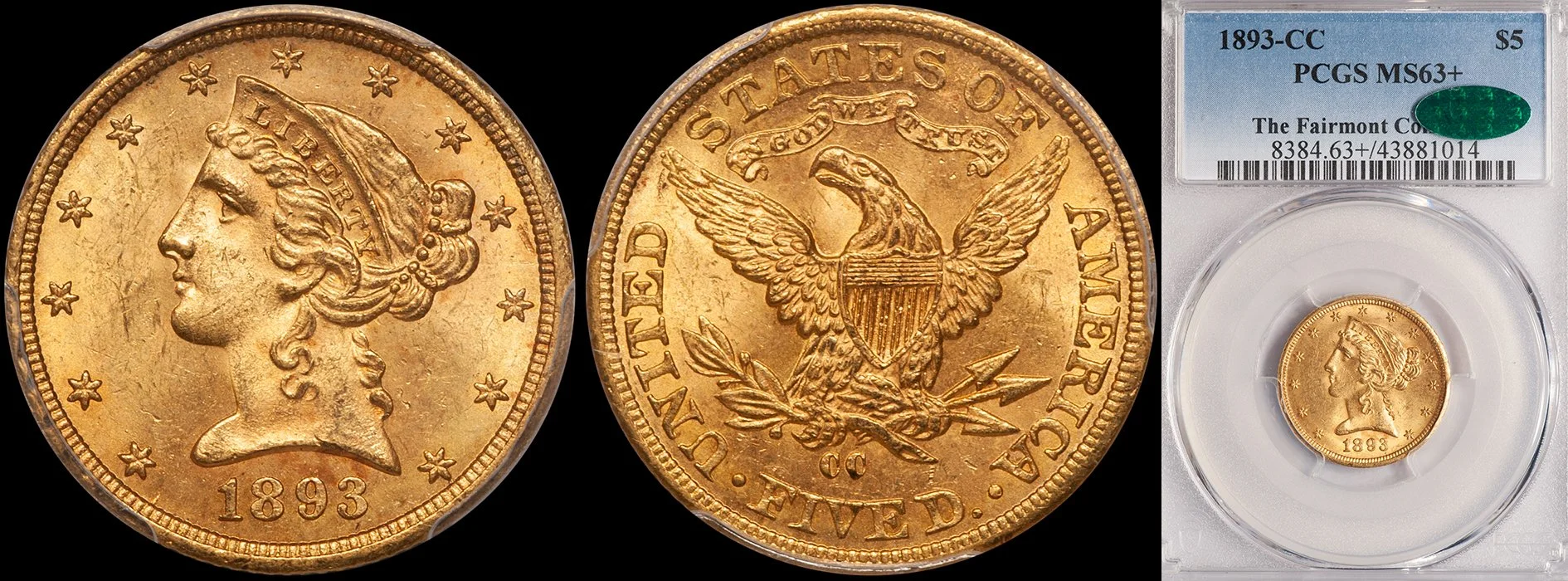So...You've Decided to Collect Gold Dollars...
/Sure - size matters - but collectors have long appreciated gold dollars, the smallest size and denomination in the annals of American gold coin issues.
The gold dollar was made from 1849 through 1889 in three distinct types and was struck at five different mints. This denomination has been popular with many generations of collectors and it lends itself to a host of different collecting methodologies. We’ll look at a number of these ranging in intensity from casual to highly dedicated.
1. COLLECTING BY TYPE
As I mentioned above, there are three types of gold dollars. These are as follows:
- Type One (Liberty Head), 1849-1854
- Type Two (Indian Head, Small Portrait), 1854-1856
- Type Three (Indian Head, Large Portrait), 1856-1889
1849-O $1.00 PCGS MS65+
The Type One issues are probably the single most avidly collected of the three. They were made at the Philadelphia mint (1849-1854), the Charlotte mint (1849-1853), the Dahlonega mint (1849-1854), the New Orleans mint (1849-1853), and the San Francisco mint (1854 only). Sub-types exist (for 1849 only) with an Open Wreath and a Close Wreath.
There is one great rarity in the Type One dollars: the 1849-C Open Wreath, of which just five are known. Discounting this issue, there are no overly difficult coins to acquire although many of the Charlotte and Dahlonega issues are rare to very rare in Uncirculated.
Most type collectors seek a single high-grade Type One issue from Philadelphia. There are a few individual coins known in grades as high as MS68 and even MS69 (!) but the collector of more modest means will likely pursue an MS64 or an MS65.
1855 $1.00 PCGS MS64 CAC
The short-lived Type Two design was made at Philadelphia in 1854 and 1855, and for just a single year at the branch mints (1855 for the three Southern mints, and 1856 for San Francisco).
1855-D $1.00 PCGS AU53 CAC
The three Southern issues are very popular with multiple levels of demand, with the 1855-D being by far the rarest. Any branch mint Type Two dollar is rare and expensive in higher grades, and the 1855-C and 1855-D are all but unknown above the MS62 level.
For the type collector, the 1854 or 1855 Philadelphia issue is the best choice. These issues are affordable in grades up through MS63; MS64 and MS65 examples are available, and at levels significantly off their market highs.
The Type Three issues are the longest lived and this design was produced from 1856 through 1889. Coins were made at the Philadelphia mint from 1856 through 1889, the Charlotte mint (1857 and 1859 only), the Dahlonega mint (1856-1861), and in San Francisco (1857-1860 and 1870).
1861-D $1.00 PCGS MS61
The rarest and most widely-known Type Three gold dollar is the 1861-D, an issue which was struck entirely by the Confederacy. But for the grade-oriented type collector, a Philadelphia issue made during the 1880’s is a prime choice. These are easy to locate and affordable up through MS65 to MS66, and are found in grades as high as MS68.
2. COLLECTING BY MINT
As discussed above, five different mints produced gold dollars over the course of this denomination’s history. In my extensive experience, I would rank the Dahlonega issues as far and away the most popular. Instead of going into great detail on each mint, I’m going to give a brief summary. Please note that these are listed alphabetically, not in order of popularity.
1853-O $1.00 PCGS MS66 CAC
- Charlotte: A total of 8 issues exist; 9 if one includes the extremely rare 1849-C Open Wreath. A nice set of EF40 to AU50 coins is an attainable goal with no real stoppers. In Uncirculated, this set is completable, but the 1855-C and 1857-C are very rare in properly graded MS61 and finer.
- Dahlonega: A total of 13 issues exist with the 1855-D and the 1861-D being the rarest. A nice EF40 to AU50 set is completable but the two key issues have become expensive in the last decade. In Uncirculated, this set is completable but the 1855-D, 1856-D, and 1860-D are very rare in properly graded MS61 and finer.
- New Orleans: A total of just 6 issues exist with none standing out as being rare. An evenly-matched AU set is easy to assemble. In Uncirculated, this set is reasonably easy to complete until you get into the heady MS64 and higher grades.
- Philadelphia: This mint struck gold dollars continuously from 1849 through 1889. In addition to the basic 41 issues, collectors typically add varieties from 1849, 1854, 1856, and 1873. A circulated set is fairly easy to assemble with the two scarcest issues being the 1863 and the 1875. Uncirculated sets can also be assembled even in lofty grades (MS65 and higher). This is a good option for someone who likes conditionally scarce and cosmetically appealing coins.
- San Francisco: Only 7 issues were made at this facility but all 3 design types are represented. A circulated set is easy to complete and affordable. An Uncirculated set is far more challenging with many of the San Francisco dollars extremely hard to locate above properly graded MS62 to MS63.
For the collector with a limited budget, I would suggest the short, modestly-priced New Orleans set. A slightly larger budget will want to focus on the San Francisco coins. And for a reasonably large budget, I would lean towards the fascinating Dahlonega issues.
3. COLLECTING BY YEAR
If you’d like to make a fairly significant commitment to this denomination but you don’t want to assemble a complete set, you might choose to collect one example of each year in which gold dollars were struck. To choose an example, let’s use 1851. During this year, four mints produced gold dollars: Philadelphia, Charlotte, Dahlonega, and New Orleans. The year collector needs to select just one of these to be “complete” for this variation. A nice 1851-P dollar in MS64 can be obtained for around $1,250, while an MS63 1851-O dollar in MS63 should run around $1,750. The Charlotte and Dahlonega issues are, of course, considerably more expensive, especially in high grade.
1863 $1.00 PCGS MS64
The two most challenging dates for a gold dollar year set are 1863 and 1875. Both are one-issue years with only Philadelphia coins made. The 1863 is very popular due to its Civil War issuance and it is a scarce issue. It has become hard to locate a nice example for less than $5,000 and the finest known, an amazing PCGS/CAC MS68 brought a world-record $193,875 in the Heritage 2015 ANA sale. That said, I recently sold a solid PCGS MS64 for around $13,000.
1875 $1.00 PCGS MS65 CAC, Old Green Holder, ex Vasquez Rocks Collection
The 1875 has long been a famous date due to its business strike mintage of only 400 coins. It is less rare than typically stated (as many as 100 are known), and $7,500 will buy the collector a nice AU example. A grade-conscious collector will want at least an MS64 which should be available for around $30,000.
A few tidbits of advice for a gold dollar year collection are as follows: First, make certain to throw in a decent smattering of branch mint issues; certainly at least one from each facility. Second, be consistent with your grades. If you are working on a circulated set, stay in the EF45-AU55 range. If you are working on a higher grade set, be consistent and resist the temptation to overbuy the common dates. Finally, be patient and wait for well-struck, choice coins with natural color and pleasing surfaces.
4. ASSEMBLING A COMPLETE SET
There can only be a total of five truly complete gold dollar sets due to the fact that there are just five 1849-C Open Wreath dollars known. Of these five (three of which I have handled) none is currently available, making this a potentially difficult endeavor.
A gold dollar set can still, in my opinion, be “complete” without the 1849-C Open Wreath.
There is no really “cheap” solution for the collector who decides to work on a complete set. Unless you use “no grades” for the rarities (a terrible idea in my opinion) you are looking at a minimum of $50,000-60,000 to acquire decent quality examples of the 1855-D and the 1861-D. Other coins which might require five-figure expenditures are the 1854-D, 1855-C, 1856-D, and 1860-D.
1850-C $1.00 PCGS MS62
I would say that it is pretty easy to assemble a complete set of gold dollars in circulated grades. Assembling a set in Uncirculated is another story altogether. I regard the following gold dollars to be very rare in properly graded Uncirculated: 1850-C, 1850-D, 1852-D, 1854-D, 1855-C, 1855-D, 1856-D, 1857-C, 1857-D, and 1860-D. Many of these dates have fewer than 10 separate Uncirculated coins in holders, and some have no more than three to five pieces in what I view as really Uncirculated and which I would write a check for.
1856-D $1.00 PCGS MS60 CAC
Is it possible to assemble a complete gold dollar set with all CAC approved coins? The answer is yes, but a few dates will prove really tricky. As of August 2017, only two 1854-D gold dollars have been approved (EF45 and AU58) while only five 1856-D dollars have been approved. Other issues with low CAC approval include 1855-D (seven), 1857-C (nine with none higher than AU58), 1858-D (six), 1863 (also six).
5. COLLECTING PROOFS
I have had the good fortune to assemble some interesting sets of Proof gold dollars.
Proof Type One gold dollars are exceedingly rare and their very existence is controversial (I believe that a very limited number of 1849 dollars are Proofs but that no other dates exist in true, no-questions-asked Proof) while Type Two gold dollars exist in Proof and are extremely rare.
For most collectors, a set of Proof gold dollars begins with the 1856 and ends with the 1889. Mintage figures range from a low of 20 (in 1874 and 1875, and again in 1877 and 1878) to a high of 1,779 in 1889.
1856 $1.00 NGC PR66★ Ultra Cameo CAC
The two rarest Type Three Proofs are the 1856 and the 1857, both of which have an estimated surviving population of fewer than 10 coins. Other dates I regard as rare to very rare include the 1858, 1864, 1865, 1868, 1869, 1871, 1873, 1874, 1875, 1877, 1878, and 1879. All of these have fewer than 20 known and many are very rare to extremely rare in Gem Proof (65 and finer).
Proof gold is obviously very expensive and this is a project which requires deep pockets. However, you get a lot of bang for the buck with Proof gold dollars and in many instances, $25,000 will buy you a pretty exceptional coin. Obviously, this is a lot of money but in larger denominations such as half eagles and eagles, you need to spend more like $50,000 to $75,000 to obtain an impressive example of a truly rare coin.
1872 $1.00 PCGS PR66 Deep Cameo CAC
There are 34 different Type Three issues which are obtainable in Proof. If a collector were to budget $30,000-40,000 per issue it might be possible to assemble a world-class set of Proof gold dollars in the $1,000,000-1,250,000 range.
There is one more point to consider. Proof gold is found with two adjectival modifiers: Cameo and Deep Cameo. Most Proof gold dollars will be, at the very least, designated as Cameo and the collector shouldn’t really have to pay much of a premium for such a coin. It is more complex to determine what sort of premium a Deep Cameo deserves. Certain dates are really rare with this modifier. As an example, all gold Proofs dated 1871 are seldom seen with strong contrast and the current PCGS population for Deep Cameo is just one coin, a PR65. If this coin were made available, the specialist would likely have to pay at least a 50% premium over a regular Proof (or one designated as a Cameo).
6. VARIETIES
There are some basic varieties which every gold dollar collector recognizes and includes in his set. These include the 1849 Open Wreath and Close Wreath, the 1849 Small Head with no L on the neck, the 1854 Type One and Type Two, the 1856 Upright 5 and Slant 5, and the 1873 Closed 3 and Open 3.
There are a few other varieties which are sometimes included in advanced sets. Some of these are as follows:
1856-S/S $1.00 NGC AU58 CAC
- 1856-S/S: Some 1856-S dollars show a boldly repunched mintmark which is easy to see with a 5x glass.
- 1862 Double Die Obverse: Much of the obverse shows noticeable doubling, especially the lettering. This variety appears to be scarce.
- 1874 Without LIBERTY: On this variety, most or even all of letters in LIBERTY have been polished off the headband. This is common.
7. CONCLUSION
As collectors get older, gold dollars become hard to see without magnification. That said, this is such an interesting series that I believe it has a bright future. I feel that collecting gold dollars by mint has the most upside in the future, and that of the five mints that produced these coins, the Dahlonega issues will continue to be the most popular and the most valuable.
Would you like to assemble a set of gold dollars while working with the leading expert on these coins? Contact Doug Winter by email at dwn@ont.com or call him at 214-675-9897 to have a “dollar discussion.”






















